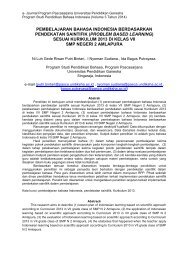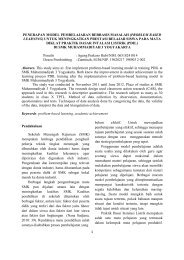Create successful ePaper yourself
Turn your PDF publications into a flip-book with our unique Google optimized e-Paper software.
1 Atomic structure and the periodic table<br />
TIP<br />
1 nm = 1 × 10 −9 m (0 .000 000 001 m)<br />
TIP<br />
The SI units for length are metres (m).<br />
KEY TERMS<br />
Proton Positively charged particle<br />
found inside the nucleus of atoms.<br />
Neutron Neutral particle found inside<br />
the nucleus of atoms.<br />
Electron Negatively charged particle<br />
found in energy levels (shells) outside<br />
the nucleus inside atoms.<br />
Nucleus Central part of an atom<br />
containing protons and neutrons.<br />
3D diagram<br />
nucleus containing<br />
protons and neutrons<br />
electrons move<br />
around the<br />
nucleus in energy<br />
levels (shells)<br />
2D diagram<br />
Key<br />
proton<br />
neutron<br />
electron<br />
The nucleus is tiny compared to the size of the atom as a whole. The<br />
radius of the nucleus is less than 1/10000th of that of the atom<br />
(1 × 10 −14 m). This difference in size between a nucleus and an atom<br />
is equivalent to a pea placed in the middle of a football pitch.<br />
Energy level (shell) The region an<br />
electron occupies outside the nucleus<br />
inside an atom.<br />
▲ Figure 1.1 The size of the nucleus compared to the atom is like a pea compared to<br />
a football pitch.<br />
The nucleus contains protons and neutrons. These are much heavier<br />
than electrons. This means that most of the mass of the atom is<br />
contained in the tiny nucleus in the middle.<br />
Test yourself<br />
1 The radius of a hydrogen atom is 2.5 × 10 −11 m. Write this in<br />
nanometres.<br />
2 Carbon atoms have a radius of 0.070 nm. Write this in standard form in the<br />
units of metres.<br />
3 The radius of a chlorine atom is 1 × 10 −10 m and the radius of a silicon<br />
atom is 0.060 nm. Which atom is bigger?<br />
4 Sodium atoms have a radius of 0.180 nm. The nucleus of an atom is about<br />
10 000 times smaller. Estimate the radius of the nucleus of a sodium atom.<br />
Write your answer in both nanometres and metres.<br />
KEY TERM<br />
Atomic number Number of protons<br />
in an atom.<br />
● Atomic number and mass number<br />
The number of protons that an atom contains is called its atomic<br />
number. Atoms of different elements have different numbers of<br />
protons. It is the number of protons that determines which element an<br />
atom is. For example, all atoms with 6 protons are carbon atoms, while<br />
all atoms with 7 protons are nitrogen atoms.<br />
4





